Gypsy Swing as a Medium for Virtuosic Gestures
Virtuoso Performers and Virtuosic Gestures
Research on human perception of sounds has indicated that people possess much ecological knowledge on sounds originating from different materials and objects (Giordano 2003:1-16). Because of the experiential knowledge acquired in our ecological habitat, we have learned to distinguish both resonant sound sources (tense objects, tubes, membranes, metal, hollow objects, etc.) and different touches that make those sources vibrate in a certain way. In the course of our daily lives we also acquire enough tacit experience on human movement to develop a sense of how musical instruments are played (see Godøy, Haga, and Jensenius 2003 for a discussion on “air” or mimicking of playing musical instruments). Skilled movements that produce musical sounds on delicate instruments are, on a general level, not at all foreign to us: horns are blown, strings are plucked and drums are struck, and therefore part of the “feeling” in musical sound comes from the way that it is corporeally produced (Baily 1985:237). It is in this way that idiomatic features of musical instruments are able to become a part of musical communication between the performers and their audiences.
Ecological knowledge about musical instruments and the way they are played also makes us all expert judges in terms of the capabilities of the performing musician, and it is this ecological knowledge that makes us feel awe when faced with a masterful performance of a virtuoso musician. Today we are likely to associate the term virtuoso solely with individual excellence in performance, but in its original Italian usage in the sixteenth and seventeenth centuries a musical virtuoso was likely to be a skilful composer, theorist or maestro di cappella highly trained in music theory. However, already during the Renaissance virtuosic solo repertoire began to emerge for instruments such as the lute. Practical facility began to be merited with the epithet virtuoso more pronouncedly with the flourishing of the opera, instrumental concerto in the eighteenth century, popularity of public concerts for middle-class audiences, and solo recital in the nineteenth century; by that time the term virtuoso had become restricted to those performers, both vocal and instrumental, whose technical accomplishments would be able to dazzle the public. With the eventual abundance of self-pronounced virtuosos in the highly competitive touring circles of nineteenth century Europe, the whole concept of virtuoso became treated with suspicion, and pejorative terms such as Virtuosenmacherwerk, a musical piece for display of virtuosic routines, emerged. (Jander 2002:789; Walser 1993:75; Weiss and Taruskin 1984:430).
Those routines, virtuosic gestures, were hated by Adorno, but the public from Baroque courts to rock festivals has always loved those jaw-dropping sleights-of-ear performed on violins, pianos, guitars, and other tools of music. A virtuosic gesture as defined in this essay is a) relatively economical to execute on the interface of a given instrument, and b) sounds impressive judged according to the audience’s ecological knowledge concerning the possibilities of musical instruments and the limits of the human motor capabilities. In its purest sense, virtuosic gesture only implies virtuoso performance, although in practice the difference is most often irrelevant. Conceptually, however, there exists a difference: if virtuoso performance denotes total control of the instrument, a virtuosic gesture amounts to something that sounds more impressive than what it actually is to execute (even if the gesture is actually hard to execute). Nevertheless, even if playing virtuoso-gestures is not to be confused with virtuoso playing as such, a musician who would not utilize the idiomatic possibilities of his or her instrument would hardly deserve to be called a master of that instrument. In fact, many of those musicians who have been merited of true innovators of their instrument have been merited so because they have transcended their instruments in a technological sense, be it Franz Liszt in the late 1830’s who took the mechanical potential of the piano to its limits, or Eddie Van Halen in the late 1970’s, who transformed rock guitar with an innovative playing technique that depended “upon the capabilities of amplification equipment that can produce very high electronic gain and indefinite sustain” (Walser 1993:68).
There is a certain give-and-take regarding the interfaces of musical instruments. As some musical procedures or effects are hard to accomplish on a given instrument, some other musical features become effortlessly executed: these procedures are usually referred to as being instrument idiomatic. It has long been noted by some writers that there exists a direct link between any given musical style and the musical instruments involved in the production of that style. Curt Sachs (1962:110) wrote, “The instrumental impulse is not a melody in a ‘melodious’ sense, but an agile movement of the hands”; John Blacking (1955), in his studies on the Nsenga kalimba and the Butembo flute, suggested that the shape of the music was influenced by the spatial properties of the instrument; John Baily (1985) showed how the music of the dutar, a stringed instrument from Afghanistan, was adopted to the performance of music associated originally with another regional plucked lute, and changed the music according to the dutar’s physical characteristics in the process. In this essay it is argued that also expressive gestures of musical styles are essentially rooted in the tactile possibilities allowed by musical instruments. Robert Hatten, in his influential definition of musical gesture as energetic shaping through time, states,
Musical gesture is biologically and culturally grounded in communicative human movement. Gesture draws upon the close interaction (and intermodality) of a range of human perceptual and motor systems to synthesize the energetic shaping of motion through time into significant events with unique expressive force. The biological and cultural motivations of musical gesture are further negotiated within the conventions of a musical style, whose elements include both the discrete (pitch, rhythm, meter) and the analog (dynamics, articulation, temporal pacing). Musical gestures are emergent gestalts that convey affective motion, emotion, and agency by fusing otherwise separate elements into continuities of shape and force. (Hatten 2004:95)
In order to explain the cultural appeal of virtuosic gestures in music, in this essay it will be asked whether the appeal may ultimately be a result of the way those gestures approximate special dynamic gestures, vitality affects, amodal forms of sensing which are included in all the vital processes of life. The theory of vitality affects was originally presented by developmental psychologist Daniel Stern (1984, 2010), who argues that dynamic forms of vitality are the most fundamental of all felt experiences when dealing with other humans in motion in our everyday lives: they fine-tunes our interpersonal interactions, but where their essentiality really becomes apparent is in human activities such as team sports, or performance in the time-based arts, where the dynamic features of a performance have been amplified, refined, and rehearsed repeatedly.
Below, virtuosic gestures are elaborated in the context of a special genre that has been an important part of Middle-European gypsy music ever since American swing reached the caravans of the Gitane, Manouche, and Sinti tribes. The key stylistic elements of a gypsy swing performance are speed, pronounced vibrato, dramatic diminished arpeggios, and subtle use of dynamics. A very important part of the style is the vocabulary of impressive, recurring melodic devices, that are rooted in a motor movement encouraged by the special acoustic and spatial properties of the type of guitar used in that style, the Selmer-Maccaferri steel string guitar.
Eighty Years of Gypsy Swing
Gypsy or Roma1 musicians have been playing lutes or plucked instruments for more than 500 years in the royal courts of Europe (Kertesz-Wilkinson 2001:614), as well as for peasants in taverns and at weddings, baptisms, circumcisions, fairs, village dances, and other events (Silverman 2000:270). The term gypsy music acquired its broader meaning as the gypsy image brought exotic substance to the arts of the romantic era; Franz Liszt stated that when a gypsy fiddler improvised on a tune, he was able to produce the kind of music that synthesized the rational and the irrational, technical competence and depth of feeling (Malvinni 2004:x). Roma entertainers came to occupy a special place in the imagination of the European public. Genres which embody gypsy music in the mind of today’s audience—Spanish flamenco, Hungarian primás-tradition, Romanian taraf-orchestras as well as the genre of Russian gypsy romance—developed in urban surroundings during the eighteenth through early twentieth centuries. Such is the case also with gypsy swing (sometimes also called gypsy jazz or manouche jazz due to its French origins).
The gypsy swing style was created by guitarist Jean Django Reinhardt (1910–1955) and his contemporaries in various popular musette ensembles around Paris in the 1930s. The music, consisting first of walzes and tangos, evolved into an original form of swing during the early years of the 1930s when American “hot” jazz took Middle-Europe by storm. The original accompanying banjo, also Reinhardt’s first instrument, was superceded by the more flexible guitar in a similar manner as in the USA. Reinhardt, the most prominent of the circle of gypsy swingers, was the one to enjoy an international career with his partner, violinist Stephane Grappelli and their group Quintet de la Hot Club de France. The Belgian-born guitarist astounded audiences all over the jazz-crazed Europe of the 1930s and 1940s with his phenomenal playing.
Although gypsy swing began to sound dated already in Reinhardt’s time with the development of bebop, his legacy still lives on not only in France but all around the globe. Django Reinhardt’s approach continues to form the basis for the surviving gypsy jazz guitar style to this day. The style was preserved for decades, largely out of the public eye among the Manouche, Gitane, and Sinti gypsy tribes of Middle-Europe. Django’s recordings were copied on tape cassettes when these became available (Dregni 2004:273), and his solos were learned note by note. Gypsy swing of the decades after Django’s death are documented only on a small number of obscure recordings, but beginning in the 1980’s, an international revival of gypsy swing took place. An annual festival dedicated to the heritage of Reinhardt and his fellow Gypsy guitarists is held in Samois-Sur-Seine near Paris, and serves as a center for not only Gypsy musicians, but thousands of gypsy swing afficionados around the world. Today, gypsy swing is played from the Far East to the Americas with the Internet serving as the connecting medium of the blossoming global community. The local styles of the different Roma tribes are, in a global context, being exchanged for a more generic gypsy swing guitar style. It does however, retain the basic principles of performance on a particular design of steel string guitar conceived by the Italian luthier Mario Maccaferri and produced by the French company Selmer in the 1930’s. Indeed, the Selmer-Maccaferri guitar type with its unique features is a central ingredient in the convincing execution of the style.
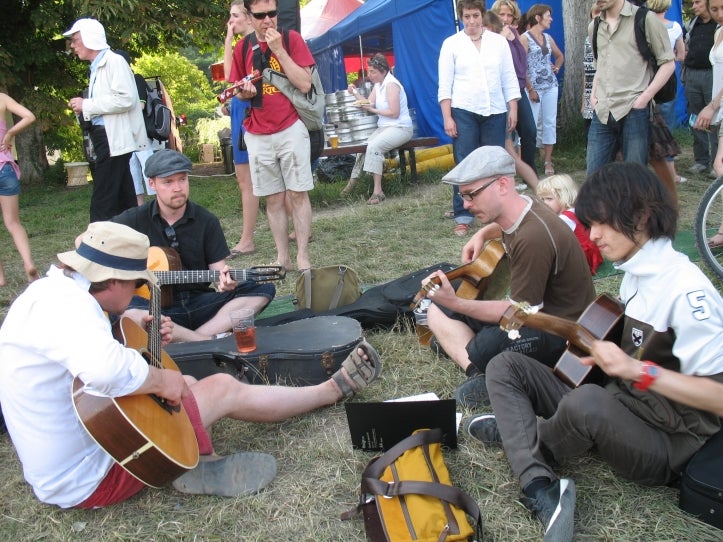
Figure 1. Group of visitors at the Festival Django Reinhardt in Samois-Sur-Seine in 2010. Informal groups playing Django tunes are a common sight at the annual festival. Three of the participants of this jam session are playing a Selmer-Maccaferri type guitar, the player on the foremost left using a Martin-type steel-string guitar. Picture: Katri Somerjoki.
Quite on the contrary to his American bebop-guitarist contemporaries who chose to play in the “un-guitaristic” keys of E-flat or B-flat for the sake of compatibility with wind instruments, Reinhardt made full use of the idiomatic features and sonorous capabilities of the acoustic guitar. Playing often in sharp keys of D and G, Reinhardt was compatible with another distinctly European jazz-instrument, violin. But more importantly, he was able to use the free strings (E, A, D, G, B, E) and the full four octave ambitus of his guitar to great effect. Fully in keeping with his gypsy heritage, his pyrotechnics were largely based on pre-learned motor gestures, highly guitar-idiomatic “licks,” some of which were so rapid that they were quite un-analysable by ear alone. That Reinhardt had lost use of some of his left hand fingers in an unfortunate accident has much contributed to the creation of his legend, although in practice his physiological limitations have never inspired later prominent players to the point of assimilation. The internationally famous performers of the style, such as Bireli Lagrene, Stochelo Rosenberg or Joscho Stephan, are all known for their breathtaking technical capabilities. Gypsy swing presents an apt object of study in terms of virtuoso gestures in musical performance and the way these gestures are affected by the tactile possibilities allowed by a musical instrument.
The Selmer-Maccaferri Guitar
The stylistic features of gypsy swing have a special relation to the peculiarities of the Selmer-Maccaferri guitar construction. The guitar associated with the gypsy swing style was designed by the Italian artist and luthier Mario Maccaferri (1900-1993) during the pre-World War II swing era. The design aimed to achieve a sound that could be heard properly in the context of jazz bands of the acoustic era. Generally speaking, using an unamplified acoustic guitar as a solo instrument in an ensemble is challenging. Other instruments that were popular in pre-World War II jazz—piano, trumpet, clarinet, saxophone, drums, and violin—were loud enough to be heard in a noisy dance-hall, but the guitar could not compete with the loudness of those instruments. In 1932 Mario Maccaferri teamed up with French instrument manufacturer Selmer to produce his novel guitar models, which he had innovated based on his experiences as an apprentice instrument maker, and in his own workshop in Cento, Italy (Charle 2008:28). Maccaferri, himself also a performing classical guitarist, was primarily concerned with gut strung models of the line bearing his name; however, as the jazz craze had caught on in France, the Orchestre model with steel strings was included from the beginning. After just over a year Maccaferri left the Selmer company, but Selmer continued to make the Orchestre model with some modifications, now renamed Modèle Jazz, until 1952.2
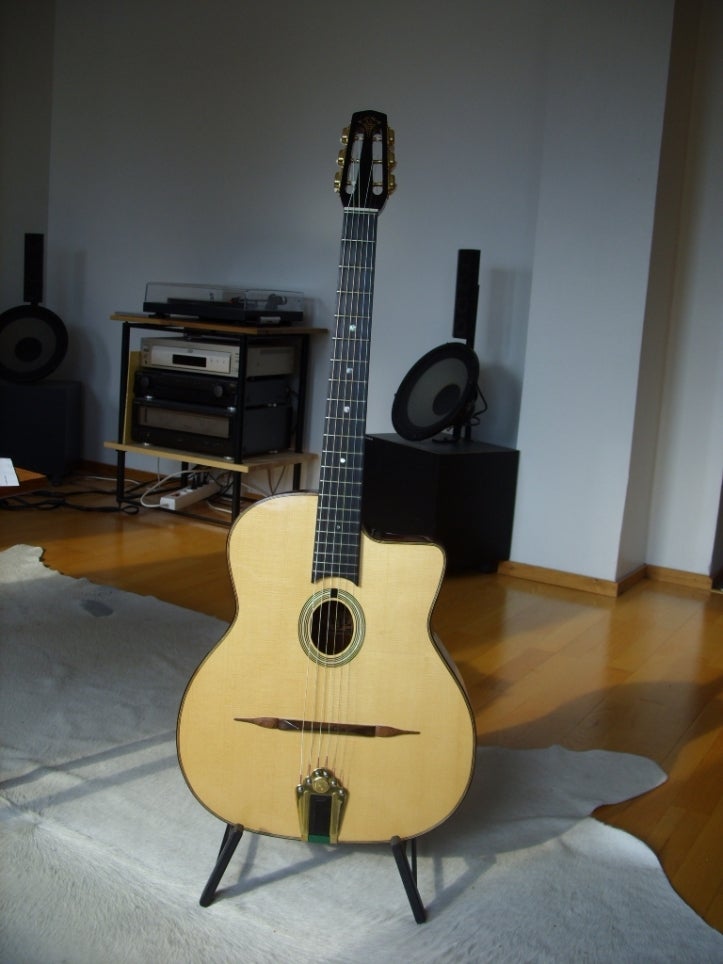
Figure 2. Copy of a Selmer Modèle Jazz of the brand AJL, the producer of exclusive hand-made Selmer-Maccaferri type guitars. Picture: Marko Aho.
A major factor in the exclusive continuation of this particular model must have been the commercial contribution of the endorsement of the world-famous Django Reinhardt. Many smaller manufacturers made copies of the rather costly Modèle Jazz already during the Selmer production period. Nowadays these types of instruments are produced by an increasing number of luthiers making high end hand-made guitars, as well as brands delivering consumer-level instruments made in Far Eastern plants. Only a limited number of highly prized original Selmers have been preserved in playing condition.
A Selmer-Maccaferri guitar sounds unlike any other guitar design. The guitar of this type possesses a unique bright and cutting, “twangy” or non-linear tone, which changes in a wonderfully lively way throughout its decay. The construction of a high quality Selmer-Maccaferri type guitar is light with laminated back and sides and a minimum of inner bracing. The slightly domed shape of the soundboard compensates for the relative lightness of the bracing. The strings which are used are of light gauge, and they are set on a distinctly high action compared to other types of flat top steel string guitars. The scale length of the Modèle Jazz, 670 mm, is rather unusual in the world of guitars—the standard scale length of a classical guitar being approximately 650 mm.3
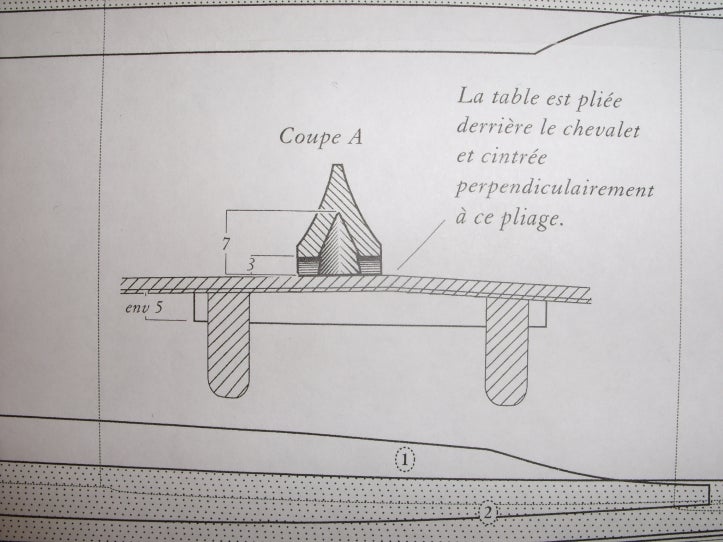
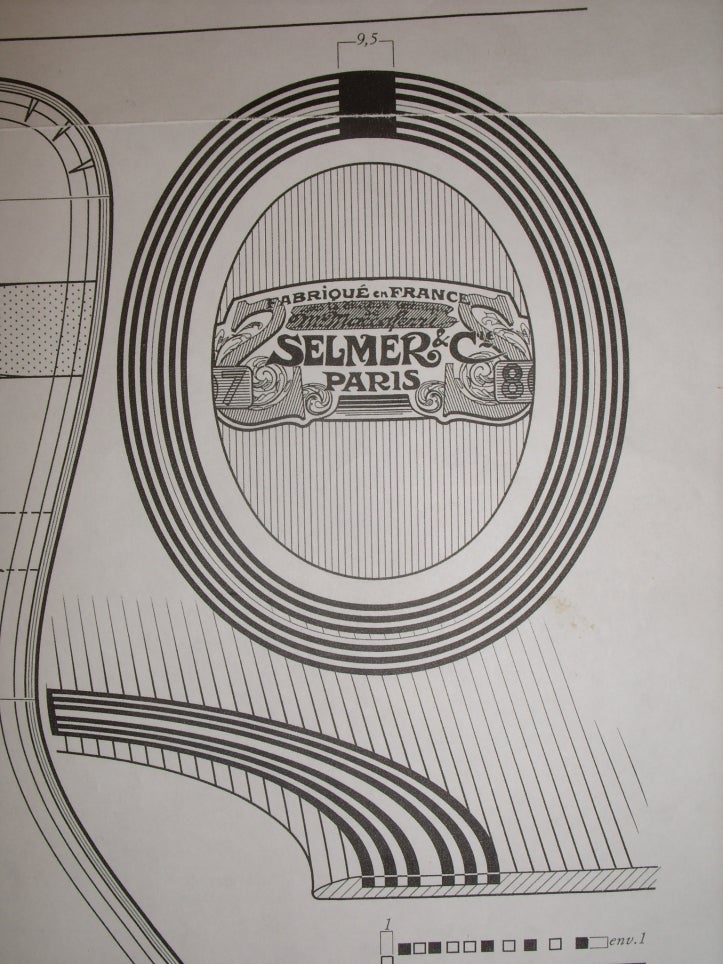
Figures 3 and 4. Details from the building plan of the Selmer-Maccaferri type guitar (© 2001 Patrick Alexandre) reveal both the thinness (only approximately two to three millimeters under the bridge) and the slightly conical shape of the top board. The conical shape is similar to that found in the Neopolitan mandolin, and it adds to the ability of the top to resist the pressure of the strings.
Lee et al. (2007) carried out a study on the characteristic acoustic functioning of the Selmer-Maccaferri type guitar. The distinctive heavy down-stroke picking, customary when playing this type of guitar, is the cause of a pitch shift heard in the sound. Initially the pick displaces and releases the string quickly on the horizontal plane. Lee et al. were able to observe that the fundamental at the onset is approximately 5Hz higher than the steady-state frequency. Furthermore, the horizontal plane vibrates at a slightly higher frequency than that of the vertical plane, even after the initial stretching of the string from the attack. According to Lee et al., the bright “twangy” sound of the guitar results for the most part from the top-plate which resonates high frequencies greater than those of the more rigid top plate of classical guitars, the plot of the driving-point impedance of the former taking place between 400 to 5000Hz. To this we might add that the overall light construction allows quick release of energy, hence the loud snappy onset and fast decay. The initial pitch-shift, the upper-partial-heavy top resonance and the fast decay together create the non-linear feel of the Selmer-Maccaferri guitar sound.
The combination of light structure, light gauge strings, high action, and long scale result in the characterised Selmer-Maccaferri tone—trebly, cutting, “twangy”—if the guitar is played in a particular way. To begin with, the picking hand should be clear of the sound-board for full vibration of the board. For full effect, the inherent features of the guitar must be combined with a special picking technique; the pick itself must be very thick and hard (Reinhardt himself possibly used large buttons or similar). Most of the picking is rest-strokes (downward strokes ending up leaning on the lower string) aiming at a strong string vibration adversely to the plane of the sound-board, as this causes the sound-board to vibrate strongly, resulting in a high volume. The movement of the picking hand comes primarily from the wrist, so that the palm holding the pick is free to bounce back and forth with ease; this movement is sometimes describe as “putting out a match.”4 If, however, the guitar is not played with the described technique, the result is a weak, thin, and colourless sound. To play the Selmer-Maccaferri guitar correctly poses quite demanding motor challenges for both hands: the picking right hand has no support from the guitar top, and the fretting left hand has to cope with the long scale of the fretboard, as well as with the high action with the strings, which both counteract the otherwise loose tension of light gauge strings.
A detail about Django Reinhardt which has most often caught the popular imagination is the fact that after being left with terrible burns on his left hand in a caravan fire, Reinhardt executed his lightning-fast arpeggios and runs with the third and fourth fingers of his left hand deformed and of very limited use (for a thorough discussion on the subject see Givan 2010:7-24). However, Reinahrdt was able to turn his limitations into assets since the remaing first and second fingers are the strongest ones. (He also used his thumb, and was able to make limited use also of his injured fingers in special chord forms [ibid.:11,28; Dregni et al. 2006:6].) Ironically, as Cruickshank in his gypsy swing tutorial (1985:29) notes, many of Reinhardt’s lines are actually easier to play with the first and the second fingers alone than with all four. Reinhadt would very often only situate two tones in an arpeggio on a single string. All in all, it is apparent that Reinhardt was able to transcend his limitations and give rise to an effective way of playing the guitar which might have not occurred to him otherwise. Once invented, guitarists with all fingers intact were free to assimilate it to the already-existing ingenius idiomatic way of playing. Reinhardt’s injury has influenced even half-serious attempts of hardcore fans to imitate it by means of bandages. In any case, it is notable that many prominent players in the style prefer to rely mainly on their first to third fingers; many players have found the “weak” little finger not able to cope with the strain of the action of the strings required in this style of playing (see Öberg and Horowitz 2005:xii).
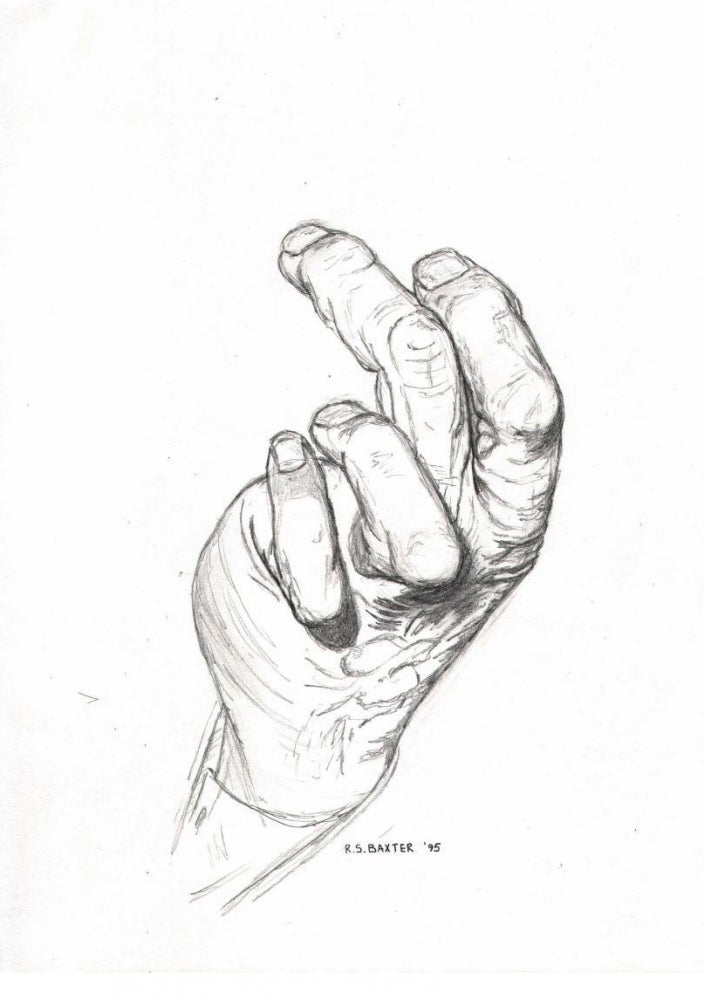
Figure 5. A drawing of Django Reinhardt’s hand. Courtesy of Roger S. Baxter.
Virtuosic Gestures in Gypsy Swing
With roots firmly in aurally transmitted folk music, gypsy swing is unique among jazz styles. Its overall feel differs to a great extent from its nearest inspiration, that of American swing of the 1930’s. The foremost trait is the ever-churning pompe, the driving rhythm created by the steady four-to-the-beat guitar accompaniment—there are no drums used in a conventional gypsy swing ensemble. The tempi are often very fast, and the Tin Pan Alley tunes that recur in the standard repertoire (such as "All of Me" or "Lady Be Good") are often performed in a tempo totally unexplored by a Charlie Christian-school jazz guitarist.5 On top of the churning pompe, the lead guitar will add the endless stream of rapid arpeggios and runs, including much idiomatic content which is familiar to the whole performing community. The improvisations are compiled, to a relatively large extent, from a stock of formulas which are linked together in an ad hoc fashion. That Django chose to play jazz relying heavily on pre-arranged formulas was no doubt affected by the oral music culture of the gypsies. Reliance on formulas has perhaps been influenced by the fact that the high string setup and unsupported picking hand, both considerable challenges for the motor skill of playing a guitar, require that every individual run or arpeggio must be performed with determination and stamina: there is little room for unprepared hand-movements which could potentially benefit formula-free improvisation. Nevertheless, as noted by Givan (2002) who analyzed Django’s solos in terms of special discontinuities in them, Django appears to have been able to perform mental shifts of attention between different modes of melodic improvisation, melodic paraphrasing, and accompanying patterns within a single solo. His playing by no means lacked versatility.
There are some key features in the technique associated with lead playing in gypsy swing style. As previously stated, alternating down- and up-strokes in the picking hand will not result in much vibration of the guitar body: only a powerful downstroke, which makes the guitar top vibrate vertically, will reveal the true dynamic potential of the guitar. It has been suggested that the right hand technique Django acquired early in his career was influenced by the flamenco practice of keeping the right hand clear of the vibrating top so as not to hinder vibration (Dregni 2004:16)—keeping the picking hand away from the top was customary also with the American swing guitarists of the pre-electric era. Arpeggios form the basis for this style of soloing. Reinhardt and his successors have developed a great many powerful effects, such as fast chordal tremolo, or the ascending single-string tremolo in which the player slides chromatically up a string articulating each note on the way in order to get a fast run covering sometimes the whole range of the guitar. Diminished runs and arpeggios, which are played over dominant chords, are in much use. Many of these common devices do not aim so much for melodic invention, but towards exploiting the dymanic and sonorous potential of the guitar.
Among the standard stock of gypsy swing devices, there are numerous ones which should be regarded as virtuosic gestures. As noted earlier, the features of musical instruments have their effects on what kind of tactile procedures come naturally and organically to the player. To this we now have to add the fact that not all possible procedures or gestures sound particularly effective or impressive, and that the musician seeks those possible and natural procedures which are most expressive. With the Selmer-Maccaferri guitar, one important feature that affects the stock of tricks is the above-discussed non-linear sound following from this particular construction. Non-linear sound can be considered by default to be more interesting than a linear sound (a non-linear sound is constantly changing and in slightly unpredictable and thus interesting ways). With a non-linear sound, an otherwise musically uninformative phrase may nevertheless come out as an interesting sound. One can play arpeggios and devices which might be monotonous but for the tingle of the non-linear sound. In fact, many devices sound somewhat dull when played on a more linear sounding standard jazz archtop guitar (Example 8).
Presented below are samples of special gypsy swing tricks and devices which should be merited as true virtuosic gestures and which I will discuss in detail. In the first two examples, the devices can be heard in their musical context. The other examples there are isolated devices.
Example 1
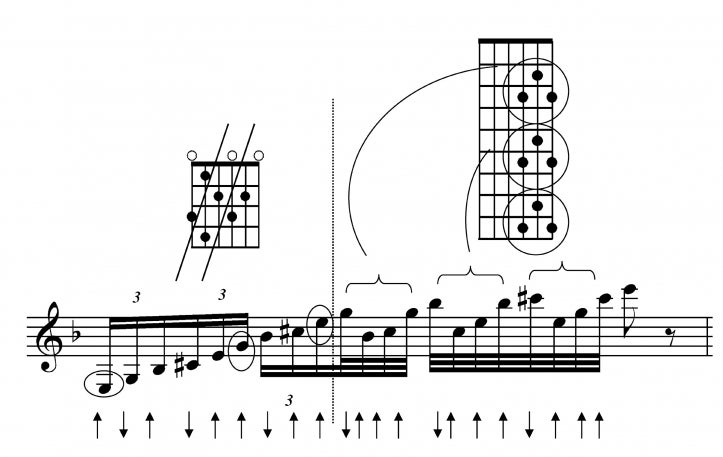
The first example is Django Reinahardt: Improvisation no 1 (DRCD11286). Django, playing solo guitar, introduces an astonishing run in the middle of a performance (at 0:03 in this clip). The dimished arpeggio, falling on the dominant chord, can be divided in two parts (the division is indicated by the dotted line): the first part consists of three triplets played on the lower part of the fretboard, and the second part of straight 32nd-notes ascending along the fretboard. In the first half, three notes are played on unstopped strings (these are indicated by a circle around them). The fretboard diagram shows the three goups (separated by diagonal lines) of two stopped and one unstopped tone each. In the second half, a simple triad form (indicated by a brace and fretboard symbols) is being arpeggiated three times, while moving it up the fretboard a diminished fourth for each successive repetition. The small arrows indicate the direction of picking; an unstopped string is always picked with a downstroke, and arpeggiated tones on consecutive strings are played with a downward sweep-stroke where possible. The halves, which are based on two different motor patterns, are united seamlessly in the example. In one short burst, three octaves of the guitar’s tonal range are let ring out. The initial effect upon hearing this is stunning; but after breaking down the device into its components, one finds the whole trick is based on uniting fairly simple motor procedures.
Example 2
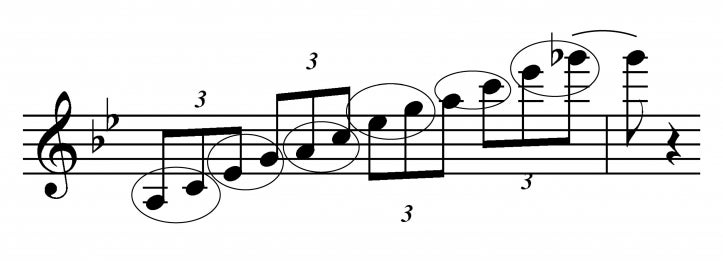
In audio Example 2, an amateur gypsy swing duo is performing Django Reinhardt’s composition Douce Ambience in G minor. In the first solo (by the author), one virtuosic gesture appears at 0:03 where there is a first, slightly ambiguous attempt on a device which is finally performed succesfully at 0:33 (see the transcription above). This particular device exemplifies well how an impressive musical gesture can be accomplished with only two fingers: the triplet patterns are organised into pairs of notes (identified with circles in the transcription), which are played always on a single string (starting on the sixth string) with two fingers before moving on to the next pair of notes and next string. The strings are played with a bouncy up-and-down alternate picking; the first note of a pair is played with a downstroke, the second with an upstroke. The percussive character of the Selmer-Maccaferri sound makes a fast run like this sound like a kind of series of explosive “pops”; much of the string’s energy is released already at the onset, and a run such as presented here allows only the most energetic part of the quickly decaying sound of each tone to be heard.
Example 3

The gesture in Example 3 is performed with a sweeping downward movement of the pick hand (sometimes called “sweep-pick” by steel-string guitar players using a plectrum) over a major triad barré-chord form.6 The direction of the “sweep” is indicated by the arrows in the fretboard diagram. The rapid succession of tones in this very swift arpeggio results in a kind of “tearing” or “ripping” feel. This device is foremost intended as a tonic major chord, and it works well as a phrase-ending on the first chord of the key. The device is acoustically very loud, since in rapid succession all the strings of the guitar give out maximum energy. Harmonically, however, this trick is based on a simple triad.
Example 4
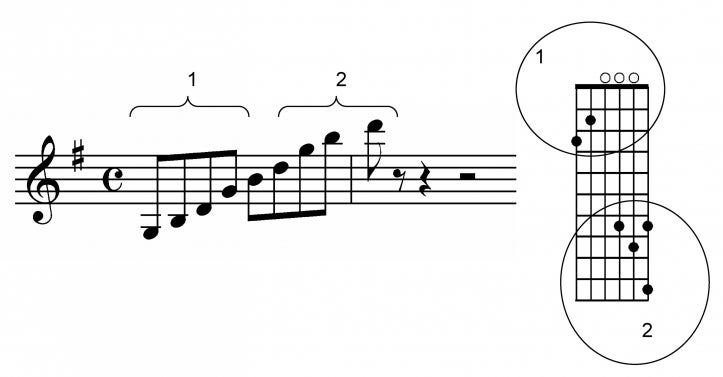
The device in Example 4 utilizes to maximum effect a large part of the tonal range of the guitar: the arpeggio is picked with two long downward sweep-strokes (with one upstroke in between). The strokes correspond to a change in left-hand position (the two positions are circled in the fretboard diagram). In the first position the left hand stops the strings in a very basic open G major chord form in a way that lets the unstopped strings ring extendedly, making good use of the guitar’s inherent “twangy” tone.
Example 5
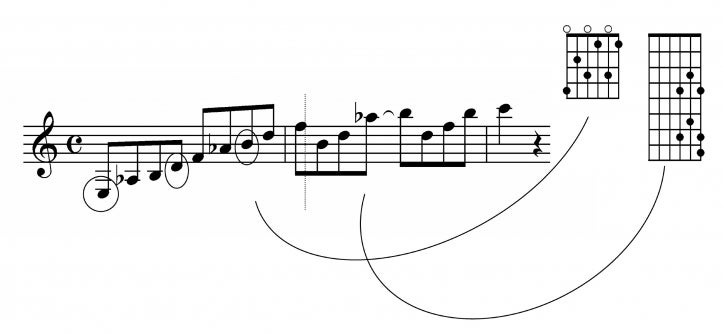
In Example 5 one of many patterns utilizing a diminished arpeggio is presented. A two-part device utilizing open strings is played on a dominant chord, and will resolve either to an A minor or C major chord. In fact, this device is a counterpart to the one in Example 1, which is also a two-part diminished pattern, but one that resolves to G minor or B-flat major.
Example 6

The latter part of the device in Examples 1 and 5 deserves special attention for its cunningness. This quite complicated sounding arpeggio is based on a simple moving triad. The left hand form moves upwards in diminished fourths, and the right hand performs a series of up-down-down-down picking sequences. This trick is very effective but requires surprisingly little effort.
Example 7

This device, a chromatic run performed with a tremolo of the picking hand, utilizes the percussive character of the Selmer-Maccaferri sound in order to produce a machine-gun-fire-like ascending run. It is performed by sliding a finger across the fretboard rather than by fingering each note separately and, therefore, can be executed without any complication using only two fingers. With this device, the player is able to play every single note within the guitar’s range in a couple of seconds.
Example 8
Example 8 illustrates the fact that on a conventional archtop guitar, the devices presented above do not sound especially impressive. This is due to the fact that the sound of the archtop guitar is more linear: excluding the decay of the sound, not much is taking place sonically. Playing a jazz solo on an archtop guitar naturally requires more melodic embellishment; passing notes, altered dominant tones—these are standard practices in bebop and mainstream jazz—more so than when playing gypsy swing on a Selmer-Maccaferri guitar. With the non-linear, “twangy” sound of a Selmer-Maccaferri guitar, even melodically simple arpeggios based on triads do not sound bland as they would if delivered on an archtop guitar. Despite the fact that bebop improvisation does always rely to some measure on a stock of melodic formulas (in fact, some bebop players use an enormous amount of stock phrases), there is usually not much content in bebop guitar vocabulary that could be thought of as virtuosic gestures as such—virtuosity yes, and gestures yes, but not a stylistic stock of especially impressive gestures as such. Another notable difference between these styles is that bebop (and earlier swing) guitar has had to adapt to wind instruments which have taken the centre stage in Afro-American jazz. This has meant that the predominant keys have been flat keys of F major and B-flat major, keys in which the guitarist has not been able to use free strings to his or her advantage.7
The Cultural Power of Virtuosic Gestures
Some instruments readily allow more range in different sound-producing gestures than others. The Selmer-Maccaferri guitar was designed in order to create an instrument capable of piercing through the noise of a cheerful Parisian establishment. Some ease of playing had to be sacrificed in the trade, but some extra unintended idiomatic potential was achieved as a bonus. The functionality—piercing loudness—of the guitar makes it somewhat lacking in terms of versatility, but those features in which it excels have been utilized to a great extent by the gypsy swing community. The cultural end product has been a particular kind of virtuosic style, packed with an arsenal of highly effective instrument-idiomatic melodic devices. The fact that virtuosic gestures add up to an important feature of the style does not mean, however, that the prominent players in this style, such as Bireli Lagrene who has been able to transcend Django’s style by fusing its vocabulary with virtuosity fashioned according to conventions of modern jazz guitar idioms, would not be true virtuosos. Even to state that there lies an economical way of executing impressive “licks” is relative, since most of these devices in fact require determined practice indeed in order to get them “right”—it would perhaps be more appropriate to propose that what the idiomatic potential of the Selmer-Maccaferri guitar enables is that the player can accomplish the “impossible” in terms of the ecologically educated expectations of the listener.
Kingsbury (1988:98,136-137) argues that the distinction between mechanical, technical mastery of performance techniques and the personal, emotional expression of a performer is a most fundamental aesthetic issue for conservatory musicians (what he actually means is the whole western concert culture). The division made in the concert world into “soul” and “chops” is not foreign to the discourse on rock guitarists either. Technique refers to the performer’s motor skill in controlling an instrument. This is a quantifiable (someone may have lots of technique) and metaphorical substance in itself. When used pejoratively, the term technical refers to the absence of feeling or expression (B.B. King expresses in a single note more than lesser guitarists do in a dozen, it has been said). However, it is obvious that a successful musical performance in general must contain both technical and expressive aspects (e.g., Gabrielsson 1999; Sloboda 1996), and furthermore, with virtuosic gestures such as in gypsy swing, the line between the technical and expressive becomes vague.
What is in common between the devices described above? What is the feeling they share? Not just any gesture will suffice for a virtuoso gesture. Many of the rapid virtuosic gestures in gypsy swing are actually performed so fast that they can not be perceived so much as melody, but rather as dynamics of texture. Seen from the viewpoint of dynamics of texture, a true gypsy swing virtuosic gesture, and in fact virtuosic gestures in any musical performance, may well receive its power from a resemblance to a meaningful dynamic quality familiar to us from our everyday lives. Influenced by art philosopher Susanne K. Langer’s idea of forms of feeling inextricably involved with all the vital processes of life (Langer 1942:226), developmental psychologist Daniel Stern has developed a widely acknowledged theory of vitality affects. Vitality affects, as opposed to Darwinian categorical affects such as hate, sorrow, joy, anger, shame, etc., are of key importance in infant life as they connect new sense-experiences with old ones. The qualities of vitality affects can be expressed in amodal dynamic, kinetic terms such as “waving,” “passing,” “flowing,” or “exploding.” These are forms of sensing, which are included in all the vital processes of life: we are never without their presence, whether or not we are conscious of them. Vitality affects are typical for infants’ experience of the world, as the infant experiences these qualities in its own behaviour and that of the mother’s. But we are in their presence also as adults in our everyday life, but most interestingly in time-based arts: cinema, abstract dance, and music. The universality of vitality affects would explain why it is not necessary to appreciate music as art to enjoy it, or why music of a foreign culture can be enjoyed without real cultural understanding of it. Let us look at a list of words describing dynamic forms given in Stern (2010:7):
explodingswellingdrawn outforcefulcrestingrushingrelaxingflutteringtenseglidingholding stillsurgingburstingdisappearingpowerfulpulsingpullinglanguorouseffortfulgentleswinginglooselyacceleratingfadingfleetingweaktentativepushingfloatingeasyhaltingtightlybounding
Not just any dynamic form will suffice for a true virtuosic gesture. Such a gesture has to have a special social meaning: virtuosic gestures are there to effect awe and respect in the listener, to “drop their jaws.” In terms of Sternian dynamic, kinetic terms, they are “exploding,” “puncturing,” “breaking” rather than “waving,” “passing,” “flowing”—potent, dangerous, manly rather than soft, and soothing or effeminite. As Robert Walser (1993:76), writing on heavy metal, notes: “Virtuosity—ultimately derived from the Latin root vir (man)—has always been concerned with demonstrating and enacting a particular kind of power and freedom that might be called ‘potency.’” If there is another similarity besides guitar-centrism between gypsy swing and heavy metal, it is patriarchality. The lack of female musicians among the gypsy swing afficionados is indeed striking.
Musical instruments, scales, and tuning systems provide only a starting point and a conceptual framework upon which musical styles, generic and individual, are built: to simplify, they define the notes to be played but not the way they are played (Theberge 1997:199). Linking virtuosic gestures with the technical possibilities allowed by a musical instrument may appear as coming close to a kind of technological determinism, as if musicians could not come up with other tactile adaptations of the Selmer-Maccaferri type guitar than the one presented in this essay. They could have, but so far they have been remarkably reluctant to do so. The historical and cultural reasons—Django’s half-religious status among the gypsy culture, the iconic nature of the Selmer-Maccaferri guitar—are beyond the scope of this essay, but they should be regarded, along with the technical reasons, central cues for the sedimentation of the gypsy swing idiom in all its tactile particularities. Still, the whole gypsy swing vibe makes sense only in context of the tactile innovations that Django made. Situating Django within a cult of virtuoso guitarists, Ben Givan writes:
The astonishing facility with which Reinhardt executed these sorts of rapid, technically daunting effects was a milestone in the historical evolution of guitar technique. Despite his handicap, Reinhardt can yet be regarded as a forerunner of the cult of guitar virtuosity that has emerged in recent decades. Neither his predecessors, such as Eddie Lang, nor other swing era guitarists, such as Charlie Christian, equalled Reinhardt’s technical achievements in terms of sheer physical speed. But since World War II, and particularly with the rise of the electric guitar, guitarists of all stripes have often placed a premium on velocity. Although such a broad trend can not be credited to any single individual, Reinhardt set an important precedent. (Givan 2010:22)
It is true what the gypsy guitarists never forget to say: nobody plays like Django. Yet one may wonder how playing exactly such as Django’s would be received in contemporary global gypsy swing scene. The general aesthetics of gypsy swing seem to have changed, especially during the years of the most recent gypsy swing revival. Gypsy swing idiom is possibly even more formulaic now than was Django’s original style. The standard repertoire is now being delivered much faster than originally by Django himself. Indeed, if there is some direction towards which gypsy swing is still evolving, it is an increase in speed; a trait which clearly lies at the core of the style as it is received today, but which held not such a central place in the times of Django himself. These kinds of developments in the aesthetic may, among other things, mark the gradual dissociation of the global gypsy swing from the initial gypsy roots.
Panning for and preparing gold, training bears, carving wood, fortune-telling, metal-working and blacksmithing, horse-dealing, sieve- and comb-making, and basketry, as well as music, have been the traditional Roma occupations in Europe (Silverman 2000:271). These occupations are well suited to the nomadic way of life. Most of the traditional occupations are some form of handicraft requiring dexterity of the fingers, and some of them require the ability to baffle the non-gypsy. Roma individuals and families often have skills in several trades in order to “play it safe.”8 There is no set of tools that would be carried along in the limited space of the caravan with such ease as one’s own hands. The Roma people have been, almost everywhere, viewed as intruders because of their dark skin and unwillingness to assimilate and give up the traditional ways they have held in their private surroundings out of sight of external society. Their exotic demeanour, vagabond lifestyle, and hidden community life excite the romantic imagination of outsiders. Sometimes mystifying, these gypsy traits works to the Roma’s advantage. It is only natural, then, that the Roma should choose to play music in a virtuosic manner, as this is perfectly in keeping with their centuries-old tradition of handcrafting, the semi-magical air surrounding them, and the need to distinguish themselves as professional musicians that are capable of delivering something special. One of the original social functions of virtuosic gestures in gypsy swing was to further one’s possibilities of professional exploitation of skills. However, playing among themselves in the caravan, the gypsy musicians had also other experiences than mere gestures of virtuosity to aim for. In the age of the internet, the gypsy approach to jazz guitar appeals to a large community of amateurs of every ethnic background around the globe, a community that has been under surprisingly little serious ethnomusicological investigation to date. Even with the emergent Django studies (e.g., Givan 2010), how this community relates to the gypsy culture in a broader sense still remains unclear.
Acknowledgements
The research on this article was financed by the Emil Aaltosen säätiö (Emil Aaltonen Foundation).
Notes
1 The term gypsy (or gipsy) is foremost an outsiders term, and carries negative connotations. It derives from the false belief that the gypsies’ ancestors came from Egypt—gypsies of course migrated from northwestern India in the eleventh century, although some groups did arrive to Europe via northern Africa. Roma has become a unifying term in the 1990’s rise of political consciousness (Silverman 2000:270). While acknowledging the potential for unintentional pejorative connotation, I choose to use the term gypsy swing for now because it is the established term within the international community.
2 The original Maccaferri design had a special patented internal resonating chamber; the extra sound-box was designed to increase volume by eliminating the vibration-damping effect of the player’s body touching the guitar. However, the benefits of this design for the jazz model (this was only one model of the Maccaferri line) guitar were arguable, and since the sound-boxes also tended to loosen and rattle, many users would eventually prefer to have them removed. After Maccaferri’s departure in 1936, the remaining Selmer workshop employees sought a design that would make the guitar easier and quicker to build. The extra sound-box was discarded, and eventually the size of the soundhole would be diminished to a small oval shape, and the original scale of 640 mm would be increased to 670 mm. (Charle 2008:passim.) Today these two models are referred to as grande bouche (“big mouth,” D-hole) and petit bouche (“small mouth,” oval hole); the former is often preferred for rhythm work, while many players regard the latter as better suited for lead playing.
3 While my custom-ordered AJL-guitar was being made by master luthier Ari-Jukka Luomaranta in his nearby workshop in Kokkola, Finland, in 2008, I was able to have a closer look at the construction methods of top-of-the-line Selmer-Maccaferri type guitars. Appreciating my interest towards fine guitars and guitar making, Mr. Luomaranta was kind enough to share his insights into gypsy swing guitar making and the international gypsy swing scene. I also had the privilege of receiving tuition to the style in many a late evening jam session. While not going into too much detail, I was able to observe that a lightness of construction was a major concern of the builder, and much attention went into trimming the top plate and the bracing in order to achieve an optimal balance between lightness and endurance. Many of the less obvious details of the original Selmer-Maccaferri design which were adopted by Mr. Luomaranta, such as the laminated sides and back or the hollowed-out bridge, were copied in the understanding that these features did in fact have an important role in the functioning of the guitar and were not there by aesthetic choice or mere chance. The small modifications to the original design made by the luthier himself seemed to be made in order to enhance the structural durability of the guitar or lightness of the construction without having a negative effect to the other variables.
4 These techniques, and the occasional fast strumming of a chord, indicate that this style of playing may have initially been influenced by flamenco playing, to which Reinhardt would have certainly had contact in his nomadic early life; for example, Dregni et al. (2006:14) tell us that in Django’s time Roma from throughout Europe came together each year for the festival days of May 24 and 25 at Les Saintes-Maries-de-la-Mer, where Gitan flamenco was played alongside Eastern European Tziganes music. From the numerous published tutorials on Django’s style I would pick out Ian Cruickshank’s The Guitar Style of Django Reinhardt and the Gypsies (1985), which presents Reinhardt’s idioms in an informative, metaphorical and illustrative manner and pays respect to the style’s illiterate gypsy heritage.
5 Charlie Christian (1916-1942) rose to fame in Benny Goodman’s band in 1939–1942. Christian was the guitarist who introduced the electrified guitar to jazz, and changed the role of the guitar in American swing from purely accompanying instrument to an instrument with solo function similar to that of the saxophone, the clarinet and the trumpet. Christian has ever since remained the archetype of an American jazz guitarist. The repertoire Charlie Christian became familiar with in Benny Goodman Sextet and the repertoire of Reinhardt’s and Grappelli’s Hot Club de France partly overlap. In a jam session in 1939 (DRCD11177) Christian and his fellow musicians played George Gershwin’s classic I Got Rhythm in a tempo of 112 bpm. In a 1935 performance Reinhardt and Grappelli played the same tune in a tempo of 144 bpm (CD AJA 5070), and Bireli Lagrene, a major performer in contemporary gypsy swing scene, played it in a very fast tempo of 152 bpm on a video recording of a performance in 2007 (see http://www.youtube.com/watch?v=-EtG_rcW93Q).
6 A barré-chord on a guitar is a form of chord which is performed up on the neck, without using open (unstopped) strings and with the index finger functioning as a kind of a capo tasto, or a zero-fret.
7 My personal experience as an advanced bebop guitarist and an intermediate gypsy swing guitarist speaks for quite a radical difference between the approach to bebop and gypsy swing improvisation. Bebop/swing idiom is more predominantly improvised on phrase-level than gypsy swing, which is to a large extent based on a set of prearranged phrases, guitar-idiomatic “licks.” All the more, these licks work horizontally across the fretboard and usually follow simple chord shapes: therefore, improvisational strategies tend to be based more on chord forms than in bebop idiom, where scalar thinking is more dominant. When starting to learn gypsy swing after years of playing bebop guitar, I soon found out that while this style is conceptually uncomplicated, relentless practice is required to obtain and maintain the strength and dexterity of, especially, the left hand. In the right hand, the challenge comes from the fact that the pick-hand must float above the strings and not get support from the guitar top. Then again, the gratifying aspect of playing a Selmer-Maccaferri-type guitar is the possibility of using vibrato (this is not done on the usually heavily-strung archtop guitar) and modifying the attack of the plectrum in order to modify the sound either subtly or dramatically, and actually play with the sound in a manner not possible on an archtop guitar.
8 This tendency actually affected Django Reinhardt’s accident, since his hands were burned in a caravan fire resulting from a bouquet of caravan-made celluloid flowers catching fire (Dregni et al. 2006:43).
References
Baily, John. 1985. “Musical Structure and Human Movement.” In Music Structure and Cognition, edited by Peter Howell, Ian Cross and Robert West, 237-258. London: Academic Press.
———. 1992. “Music Performance, Motor Structure, and Cognitive Models." In European Studies in Ethnomusicology: Historical Developments and Recent Trends, edited by Max Peter Baumann, Arthur Simon and Ulrich Wegner, 142-158. Berlin: International Institute for Comparative Music Studies and Documentation.
Blacking, John. 1955. “Eight Flute Tunes from Butembo.” African Music 1(2):24-51.
Charle, Francois. 1999. The Story of Selmer Maccaferri Guitars. Paris: Francois Charle.
Cruickshank, Ian. 1985. The Guitar Style of Django Reinhardt and the Gypsies. London: Wise Publications.
Dregni, Michel, Alain Antonietto, and Anne Legrand. 2006. Django Reinhardt and the Illustrated History of Gypsy Jazz. Denver: Speck Press.
Dregni, Michel. 2004. The Life and Music of a Gypsy Legend. Cary: Oxford University Press.
Gabrielsson, Alf and Patrik Juslin. 1996. “Emotional Expression in Music Performance: Between the Performers Expression and Listeners Experience.” Psychology of Music 24(1):68-91.
Giordano, Bruno L. 2003. “Everyday Listening: An Annotated Bibliography.” In The Sounding Object, edited by D. Rochesso and F. Fontana, 1-17. Firenze: Edizioni di Mondo Estremone.
Givan, Benjamin. 2010. The Music of Django Reinhardt. Ann Arbor: The University of Michigan Press.
———. 2004. "Discontinuity in the Music of Django Reinhardt." Current Musicology 71-73 (Spring 2001-Spring 2002):232-75.
Godøy, Rolf Inge. 2008. “Reflections on Chunking in Music.” In Systematic and Comparative Musicology: Concepts, Methods, Findings, dited by Albrecht Schneider, 117-132. Frankfurt am Main: Peter Lang.
Godøy, Rolf Inge, Egil Haga, and Alexander Refsum Jensenius. 2006. "Playing ‘Air Instruments’: Mimicry of Sound-producing Gestures by Novices and Experts." In Gesture in Human-Computer Interaction and Simulation: 6th International Gesture Workshop, GW 2005, Berder Island, France, May 18-20, 2005, Revised Selected Papers, edited by Sylvie Gibet, Nicholas Courty, and Jean-Francois Kamp. Berlin: Springer-Verlag GmbH.
Hatten, Robert. 2004. Interpreting Musical Gestures, Topics, and Tropes: Mozart, Beethoven, Schubert. Bloomington: Indiana University Press.
Jander, Owen. 2002. “Virtuoso.” In The New Grove Dictionary of Music and Musicians, edited by Stanley Sadie. London: McMillan.
Kertesz-Wilkinson, Imre. 2001. “Gypsy Music.” In The New Grove Dictionary of Music and Musicians, edited by Stanley Sadie. London: McMillan.
Kvifte, Tellef. 1989. Instruments and the Electronic Age: Towards a Terminology for a Unified Description of Playing Techniques. Oslo: Solum Forlag.
Langer, Susanne K. 1942. Philosophy in a New Key: A Study in the Symbolism of Reason, Rite, and Art. Cambridge: Harvard University Press.
Malvinni, David. 2004. The Gypsy Caravan: From Real Roma to Imaginary Gypsies in Western Music and Film. New York: Routledge.
Reinhardt, Django. In Solitaire: Complete Recordings for Solo Guitar (DRCD 11286).
Sachs, Curt. 1962. The Wellsprings of Music. The Hague: Nijhoff.
Silverman, Carol. 2000. “Rom (Gypsy) Music.” In The Garland Encyclopedia of World Music, Volume 8: Europe, edited by Timothy Rice, James Porter, and Chris Goertzen London: Garland Publishing, Inc.
Stern, Daniel N. 2010. Forms of Vitality, Exploring Dynamic Experience in Psychology, the Arts, Psychotherapy, and Development. Oxford: Oxford University Press.
———. 1985. The Interpersonal World of the Infant. A View from Psychoanalysis and Developmental Psychology. New York: Basic Books.
Theberge, Paul. 1997. Any Sound You Can Imagine. Making Music/Consuming Technology. Hanover: Wesleyan University Press.
Walser, Robert. 1993. Running With the Devil: Power, Gender, and Madness in Heavy Metal Music. Hanover: Wesleyan University Press.
Weiss, Piero and Richard Taruskin. 1984. Music in the Western World: A History in Documents. New York: Schirmer.
Öberg, Andreas and Michael Horowitz. 2005. Gypsy Fire: A Collection of Gypsy Jazz Patterns and Arpeggios for Guitar. DjangoBooks.




